Published on May 11, 2022 by Isuru Wijayasuriya and Sithijani Liyanage
Introduction
Emerging technologies are paving the way to exponential growth in a number of industries, including the airline industry. The pandemic has prompted industry participants to opt for efficient solutions and focus on digital transformation initiatives to enhance the customer experience, streamline processes and lower costs. The industry is, thus, well positioned for transformation in the early stages of the post-pandemic period.
Airlines provide transportation for passengers and cargo. To provide these services, they may lease or use their own aircraft, or combine their services with those of other companies. The airline industry is one of the industries affected the most by the pandemic and is recovering gradually. The global commercial airline industry generated USD472bn in revenue and a net loss of USD51.8bn in FY21. This revenue is still just 56.3% of that generated in pre-pandemic FY19. We expect the airline industry to grow gradually from FY22 on an economic recovery from the pandemic and rising levels of disposable income and consumer spending.
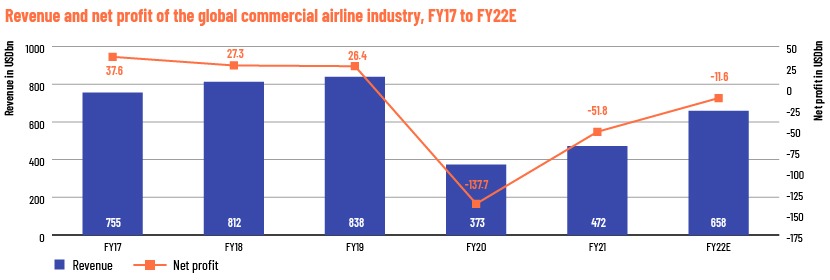
Source: Statista
Industry participants swimming against the tide by exploring breakthrough technologies
So far, the airline industry seems to be reacting to new technology rather than leading the way. Airlines are failing to keep pace with revolutionary technology changes due to the residual risk of technology advancements and the complexity of their legacy technologies. Although the effects of the pandemic present a number of challenges, we believe this is also an opportunity to adopt innovative technologies.
With demand plummeting amid the pandemic, airlines had to focus on enhancing agility and efficiencies, and reducing costs. This means that, to explore the benefits of adopting cutting-edge technologies, airlines are increasingly turning towards software and infrastructure as services. Artificial intelligence (AI), blockchain technology, big data and data transparency, quantum computing and new production tools could, therefore, disrupt the airline models currently in use. A significant 82% and 78% of airlines will undertake trials for adopting AI and business intelligence starting in 2021, respectively, according to Statista.
Share of global airlines expecting to test new technologies in the next three years
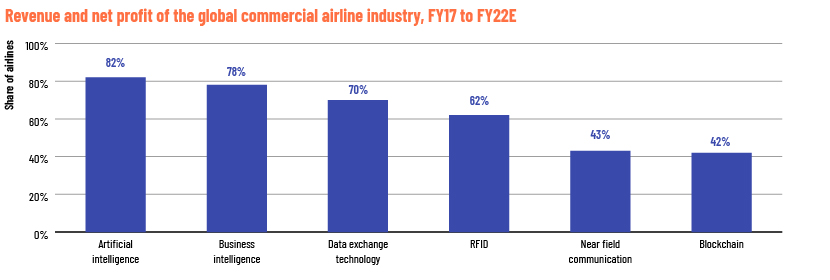
Source: Statista
Role of AI in the aviation industry
AI investment in the aviation industry reached approximately USD0.34bn in 2019 and is estimated to surge to USD3.7bn by 2027, growing at a 45.3% CAGR. However, the pandemic resulted in making AI adoption pivotal for seamless flight operations.
AI is a collection of complex machine learning (ML) algorithms developed within a computer system. It collects and analyses data with minimal human intervention to perform daily functions and make accurate decisions. The world’s leading airlines, such as Qatar Airways, Delta Air Lines and Air France, have already invested in AI applications to identify trends and draw insights from data inputs to make better decisions in areas such as customer relationship management, airline operations management, fraud detection and security management.
AI adoption in the aviation industry has the potential to improve operational efficiency and effectiveness, detect and eliminate costly mistakes, and enhance customer satisfaction in terms of customer relationship management and aviation operation management. AI technologies can be deployed in a number of areas to help the industry recover:
-
Customer relationship management
-
Aviation operations management – passengers
-
Aviation operations management – predicting air traffic and the weather
-
Autonomous machines and processes
1.Customer relationship management
The industry should be able to break new ground by enhancing the customer experience and satisfaction and conducting predictive maintenance to increase operational efficiency with modern technologies.
AI could be used to formulate optimum pricing strategies and enhance the overall flight experience. Potential post-pandemic AI use cases in the aviation industry could include the following:
-
Analysis of social media and AI-based communication
AI algorithms identify real-time customer reaction on social media platforms; this is vital for conducting customer sentiment analysis. Newly innovated communication systems, for example, chatbot software with advanced virtual assistant (AVA) applications and customer service automation systems, enable customers to book via online platforms, and AI tools enable companies to answer customer queries without human intervention. Implementing a conversational interactive voice response (IVR) system connects airlines’ contact centres and customers via fully automated or semi-automated calling systems and enhance the caller experience by eliminating delay.
Taking a fundamental approach to enhancing the customer experience, Southwest Airlines has developed an AI application to listen to customer feedback and suggestions, and enhance the quality of its operations. Although the system was implemented in 2014, the maximum benefit was derived amid the pandemic. The company also has an expert team representing its customer relations and communications, and marketing departments to monitor and analyse social media feeds. As a result, it is able to quickly resolve potential issues. The company’s AI tools capture the use of related keywords, the company’s name, competitors’ names, industry-related topics and travel destinations in social media to track demand factors. Such awareness helps the company identify current trends and provide a tailored customer experience.
-
Enhancing the quality of tailored offerings based on an airline’s biometric systems
Tracking techniques installed in AI systems help determine behavioural changes in passengers using big data analysis of purchasing history. As a result, airlines can create personalised offers, which result in cost effectiveness and enhance customer attraction and retention. AI-based biometric security systems, for example, facial recognition and fingerprint scanning, already implemented in airlines and airports, help to process passengers in line with pandemic-related health guidelines. (This is discussed in detail with a real-life example in the next section – Aviation operations management.) The same system could be used to track and get a better idea of the flow and movement of passengers across airports during lockdown. By identifying the most efficient routes, airlines could optimise costs and pass these through to passengers as optimum ticket prices.
2.Aviation operations management – passengers
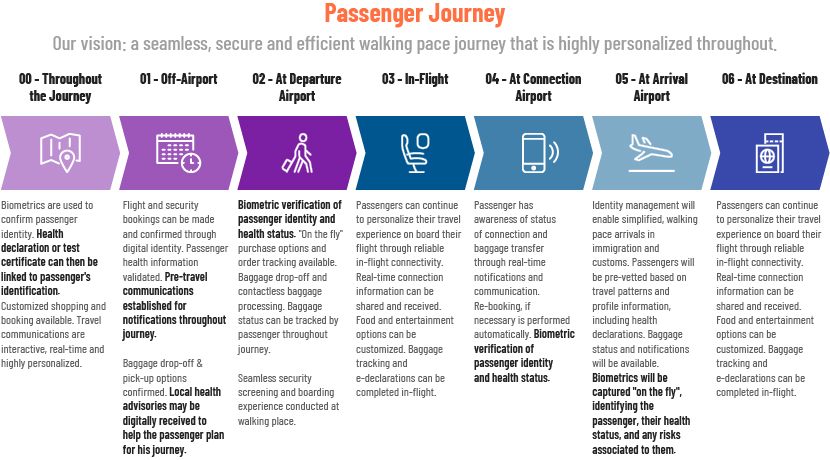
Source: https://www.iata.org/contentassets/bf24e4583c4f4e6398e3ec0b9f6335ed/nextt-vision-post-covid-19-world-1.pdf
Airlines generated significant cost benefits amid the pandemic by implementing and improving AI systems that helped optimise operations. Companies used AI-based dynamic pricing models to optimise ticket prices, based on statistics on passenger journeys amid travel restrictions. The most common variables used to optimise ticket fare were number of seats available on a plane, areas under travel restrictions/areas where restrictions are lifted, travelling patterns of passengers after large waves of infections (e.g., travel trends after the first wave in Italy) and government policies. Automated facial recognition systems, and baggage and passenger handling systems enabled a smooth flow of operations with minimal human intervention, especially amid the pandemic.
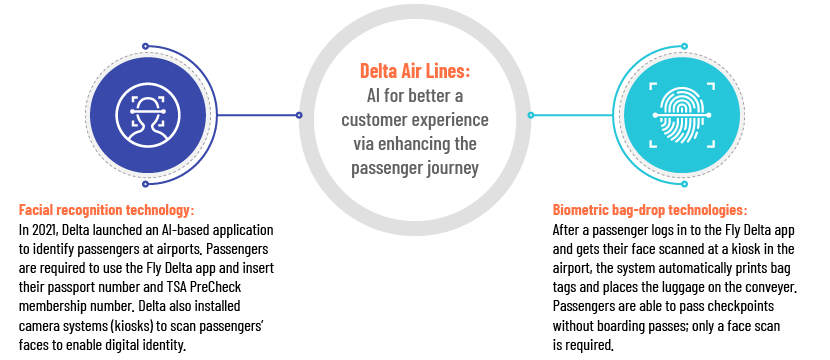
3.Aviation operations management – predicting air traffic and the weather
Air traffic management is another critical and challenging function where AI can optimise the complex process. The International Air Transport Association (IATA) expects the number of air passengers to reach 7.2bn by 2035. Although capacity requirements were affected by the pandemic, they are expected to double in the long run. As a result, air traffic is forecast to increase significantly, and airlines are keen to enhance the quality, efficiency and safety of air transportation. With demand recovering gradually, airlines are already strengthening their air traffic management systems using AI-based techniques.
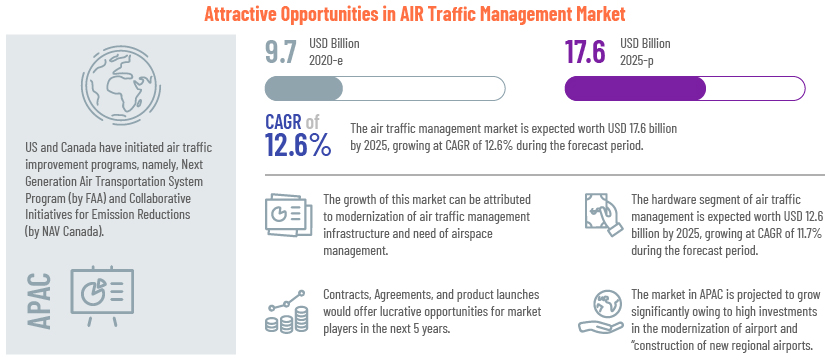
Source: https://www.marketsandmarkets.com/Market-Reports/air-traffic-management-market-160955838.html
For example, after a year into the pandemic, Alaska Airlines entered into a contract for the use of a flight monitoring and routing application based on passenger journeys in May 2021; this was to help it make better decisions on new and efficient routes. Called the “Flyways AI Platform”, it generates projections and recommendations on routings and flight operations. After six months of implementing the system, the company saw a reduction in miles, saved 480,000 gallons of fuel and avoided creating 4,600 tons of carbon emissions.
In addition to air traffic management systems, most airlines have invested in AI-based weather prediction systems to minimise maintenance-related cancelations. Delta Air Lines introduced an AI-driven platform in January 2020 to predict applicable outcomes and make better operational decisions in critical weather conditions.
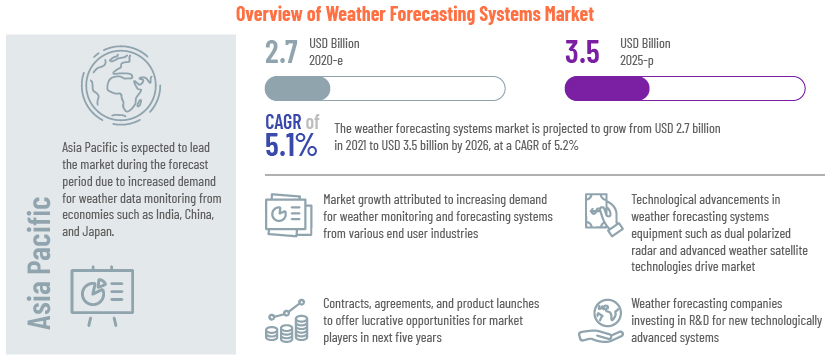
Source: https://www.marketsandmarkets.com/Market-Reports/meteorological-weather-forecasting-systems-market-29645152.html
4.Autonomous machines and processes
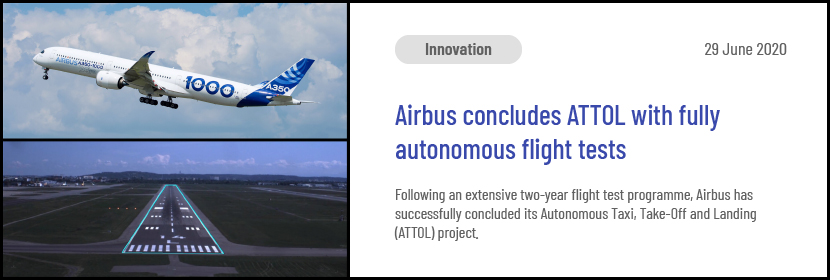
Source 6 Airbus web
A number of airlines have introduced self-flying planes powered by AI systems, but there continue to be major studies on developing autonomous aircraft using AI algorithms. Both Airbus and Boeing are attempting to gain the maximum benefit of AI adoption in aircraft control. Boeing recently successfully tested five autonomous aircraft with a speed level of 270km per hour. Airlines are also able to automate other related processes, such as ground handling at airports, loading and unloading, fuelling and aircraft safety. Airbus also uses AI applications (predictive maintenance systems) to analyse gathered data to predict delays and detect issues and other variations in its manufacturing processes. As a result, it can identify problems earlier than competitors and reap cost benefits in the long run. This enhances a company’s profitability and the quality of the customer experience.
Investment in data exchange technology and big data – crucial for reaping long-term benefits
The impact of data exchange technology including big data on the airline industry is significant. Big data plays an important role in the development of the smart aviation industry, especially enhancing safety with route planning and air traffic management, flight environment and safety management, flight management, aircraft design and performance improvement and aviation business management.
Big data can provide multidimensional real-time information, and intelligence can assist in effectively translating this information into knowledge and capability, improving the predictive and preventive management of aviation flight risks. This fundamentally enhances aviation safety, technical performance and operating conditions of aircraft, avoiding adverse external environmental conditions and reducing manual errors.
The aviation big data platform includes two aspects: aviation technology big data and aviation management big data, according to the Cogent Business & Management journal. Aviation technology big data mostly records and reflects the basic conditions of aircraft design and performance, operating states, malfunction diagnosis and maintenance to ensure improved aircraft performance and flight safety.
Aviation management big data mainly documents the state of aeronautical operations and operational performance, helping optimise aviation operations performance and ensuring aviation traffic safety. One of the two aspects under the segment, macro aviation management big data, consists primarily of the basic states of route planning and air traffic management, flight environment and safety management. Micro aviation management big data includes flight and airport management, crew management and aviation business management.
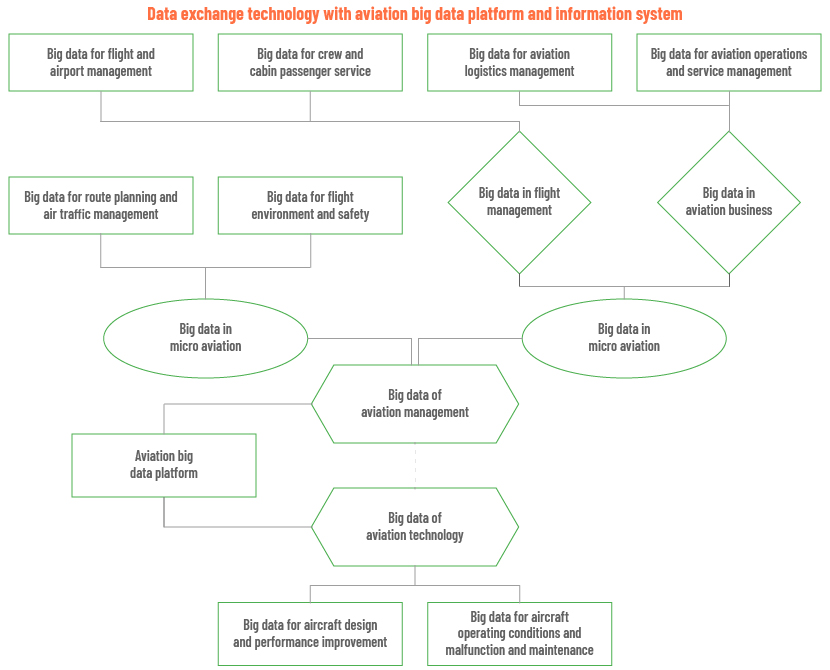
Source: Xiangsheng Dou, 2020 (Cogent Business & Management journal)
Current data exchange technology applications ensure the industry’s growth potential is tapped
The role of data exchange technology in the aviation industry will likely gain in prominence with the increasing number of aircraft with tight air route resources. The following are some recent use cases:
Safer flights:
The European Aviation Safety Agency recently launched the Data4Safety programme to record and analyse in-flight telemetry data, air traffic control information and weather forecasts to detect risk. By capturing flight-incident data, stakeholders and regulators can improve safety across the industry and strengthen weak links in the aviation chain.
In-flight intelligence:
When in-flight data generated through pilot reports, control positions, warning reports and air traffic control communications is closely monitored, it can improve safety and streamline operations. For example, Southwest Airlines has teamed up with NASA to create an automated system that can crunch vast amounts of data to flag anomalies and prevent accidents by using intelligent algorithms.
Smarter maintenance:
Big data helps airlines better maintain their aircraft. For example, as a part of its Airplane Health Management system, Boeing examines 2m conditions daily, including mechanical analysis, in-flight metrics and shop findings across 4,000 aircraft. The system helps Boeing organise maintenance and distribution while predicting failures and facilitating pre-emptive action.
Airspace management:
With increasing air traffic, airlines, Air Navigation Service Providers (ANSPs) and airports need to share information and make collaborative decisions to ensure smooth operations and safety. The IATA has collaborated with Harris Corporation to create SkyFusion, a single platform that integrates Collaborative Decision Making and System Wide Information Management (SWIM). The collaborative platform facilitates real-time operational data exchange and communication among air traffic management (ATM) stakeholder segments, offering situational awareness to optimise planning and help avoid system limitations.
Aviation blockchain market appears to be optimistic, considering recent developments and potential growth opportunities
Blockchain is a distributed ledger secured by cryptographic validation techniques; this enables recording transactions, tracking assets and building trust for aviation industry stakeholders. Using aviation blockchain technology ensures effective aerospace transactions, and operational efficiency and transparency of airlines, airports, lessors, and maintenance and repair organisations (MROs). Furthermore, members on the network have a fully transparent view of the information found therein and are associated with government regulations and directives assuring the safety and security of the related stakeholders. The following are ways in which blockchain helps improve the efficiency of airline operations:
Identity management and verification:
Streamlining the identity management of passengers and personnel using biometric data, the required documents and tickets enhance the experience while protecting privacy and enable airlines and the extensive value chain to do business in digital environments. For example, British Airways has partnered with blockchain company Zamna to use facial recognition with blockchain technology. Adhering to pandemic-related passenger requirements, Emirates Airlines and Air France are testing blockchain-powered applications referred to as immunity/health passports.
Automated payments:
Blockchain enables smart contracts that can be adopted in airline transactions such as billing between travel agencies and airlines, billing among airlines, payment of airport and authority fees and taxes and sale of travel insurance. Delta Air Lines, a member of the Blockchain Research Institute, is currently exploring the technology to allow direct and secure exchange of funds internationally. In addition, supported by the IATA Financial Development Working Group, Digital Finance will use computer program Smart Contracts to reduce airline back-office operating costs and increase back-office efficiency.
Tracking luggage and cargo:
Blockchain facilitates tracking the status and location of passenger bags and cargo at all times across the value chain as these assets change custody from the moment of deposit. A Swiss-port team developed blockchain platform BagX for luggage handling; this makes the process documentable and transparent for all stakeholders involved.
Aircraft maintenance:
An aircraft may change ownership up to five or six times throughout its lifecycle, making tracking and tracing information a cumbersome process. Therefore, an immutable record of the aircraft’s maintenance history in a digital setting could be of great value for the stakeholders involved. 14bis Supply Tracking uses blockchain technology and enables the aircraft components of the supply chain to be recorded thoroughly and with absolute transparency.
Loyalty programmes:
Many airlines allow customers to accumulate points that can then be redeemed for air travel through frequent flyer programmes (FFPs). Using blockchain technology can streamline the spending, earning, accounting and reconciliation of the points earned with the Smart Contract computer program to improve customer satisfaction. Singapore Airlines uses a blockchain application named KrisPay to offer promotions to its clientele. Virtual blockchain-based marketplace Sweetbridge is a scalable solution for multi-vendor loyalty programmes.
Blockchain technology may revolutionise airline operations in the coming years
The global aviation blockchain market was valued at USD0.42bn in 2020 and is expected to grow at a CAGR of 11.1% to USD1.15bn in 2030. This is attributable to factors such as an increase in the number of airline passengers, higher disposable income, increased tracking and transparency of aviation logs and improved safety. However, high installation costs would limit market growth.
Contracts and agreements with aviation industry participants and using AI and ML to track operations are also projected to present lucrative growth opportunities.
The market is segregated into flight and crew data management, passenger identity management, cargo and baggage tracking, supply chain management and others. Depending on the application, passenger identity management is projected to have accounted for the largest share of the market in 2021, followed by supply chain management and aircraft maintenance. The passenger identity management segment is expected to grow significantly, from USD0.11bn in FY20 to USD0.26bn in FY30, due to increasing security concerns among passengers and airlines over data breaches and fraudulent activities such as baggage theft and ticket fraud that are prompting the aviation industry to adopt blockchain technology in its operations.
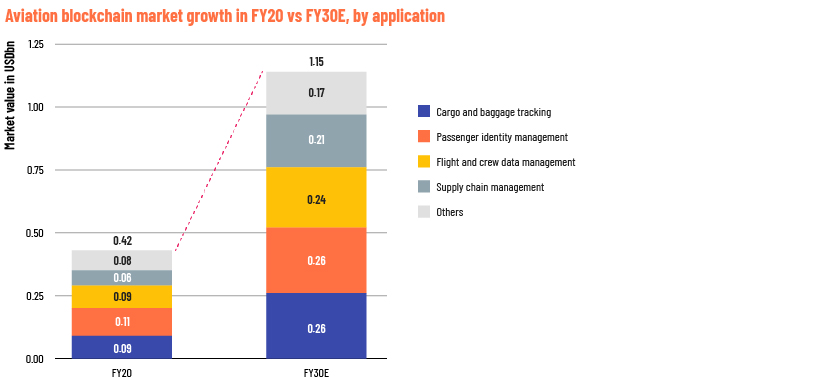
Source: Allied Market Research
Implementation of new technology leads to greater efficiency and profitability but may cause disruption
Extended lockdowns and travel restrictions caused most airlines to delay digital and technical innovation. However, some airlines considered the crisis as an opportunity to continue their digital transformation programmes, but with a laser focus. As air travel recovers, these airlines are beginning to reap the rewards of their investments. Breakthrough technologies would streamline their processes and help recover their losses over the past two years. AI and business intelligence, data exchange technology and blockchain would have a positive impact in terms of democratising access to operational, financial and legal support, bypassing traditional third-party organisations. The abovementioned technological advancements improve industry participants’ ability to track performance and outcomes, enabling them to shift their focus from operational processes to achieving specific goals. The implementation would, undoubtedly, cause disruption in the airline industry as well.
How Acuity Knowledge Partners can help
Our team of experts provides financial services, offering extensive knowledge on valuation and research that can be leveraged when adopting technology advancements or pre-investment screening to ensure investments are lucrative and aligned with targets. Our commercial lending vertical helps lenders manage and monitor loan portfolios; our analysts conduct comprehensive risk rating, covenant monitoring, customised credit reviews and other activities that provide early warning signals in line with a client’s unique needs. For research-focused or analysis-centred workflow, our team will also ensure the latest sector insights are aptly incorporated so that credit approvals are well rounded and holistic in nature.
References:
https://www.tandfonline.com/doi/full/10.1080/23311975.2020.1766736
https://www.tandfonline.com/doi/full/10.1080/23311975.2020.1766736
https://www.alliedmarketresearch.com/aviation-blockchain-market-A06275
https://industrygrowthinsights.com/report/aviation-blockchain-market/
https://www.altexsoft.com/blog/engineering/ai-airlines/
https://www.marketsandmarkets.com/Market-Reports/air-traffic-management-market-160955838.html
What's your view?
About the Authors
Isuru has over four years of work experience in Audit, Assurance and including one year in Commercial Lending. Currently he is an Associate, attached to the Transportation & Logistics (T&L) sector team and responsible for carrying out credit reviews, risk raters, covenant validation and monitoring, insurance monitoring and other credit workflows for the T&L sector of a leading European based bank. Prior to joining Acuity Knowledge Partners, he worked as a Senior Accountant in the Audit & Assurance division of one of big four-audit firms. Isuru holds a B.Sc. Accounting (Special) Degree from Department of Accounting of University of Sri Jayewardenepura and a finalist of the Institute of Chartered..Show More
Sithijani is an analyst attached to the Commercial Lending division at Acuity Knowledge Partners. She is currently a part of Transportation and Logistics (T&L) sector performing risk raters and undertaking covenant-monitoring, validation and other credit workflows for a leading European based bank. Prior to Acuity Knowledge Partners, she worked as a junior consultant authoring industry research reports at Uzabase Inc. She holds a Bachelor’s degree in Finance (Special) from the University of Sri Jayewardenepura.
Like the way we think?
Next time we post something new, we'll send it to your inbox









